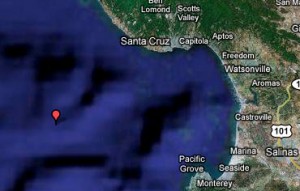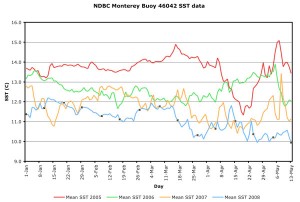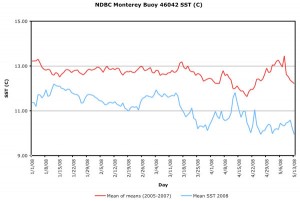There have been several reports indicating that 2008 has thus far been an exceptionally cold year for sea surface temperature (SST) measurements along coastal central California. Fortunately, there are multiple in situ platforms monitoring SST and other oceanographic and meteorological variables (e.g., salinity, turbidity, wave height, wave speed, wind velocity- see http://www.sanctuarysimon.org/regional_sections/obs/). Staff at the Sanctuary Integrated Monitoring Network (SIMoN) used data provided by NOAA’s National Data Buoy Center (NDBC) to calculate SSTs for the past three years (2005-2007) and compared them to measurements in 2008.
We used NDBC mooring #46042, which is located off the coast of Monterey Bay (Figure 1). Hourly data were downloaded from the NDBC web site and cleaned up, deleting all error (999) values. Hourly SST data were then averaged for each calendar day for each year. Daily averages (means) were then plotted for each year (Figure 2), but only from January 1 through May 13, the period of available 2008 data. Data for February 29, 2008 were deleted to make comparisons among years.
Because there is a great deal of inter-annual variability, we also created a plot that shows the daily averaged SST for the last three years (2005, 2006, and 2007; a ‘mean of means’) vs. the daily average SST for 2008 (Figure 3). For the 133 days of data (January 1st thru May 13th), the daily difference was, on average, 1.54 degrees C cooler in 2008, with a maximum difference of 3.14 degrees C on May 8th and a minimum difference of 0.18 degrees C on April 13th.
The mechanisms driving these differences are not completely understood, but it is likely that the numerous windy days this late winter and spring have contributed to the colder SST measurements. When sustained winds blow from the northwest they drive a process called upwelling. Because of Ekman transport, coastal surface waters move offshore when NW winds blow and are replaced by deeper-and colder-waters that bring nutrients with them, which in turn drives high biological productivity (see http://www.sanctuarysimon.org/monterey/sections/oceanography/overview.php?sec=o).


